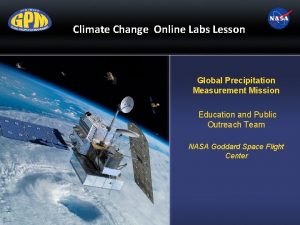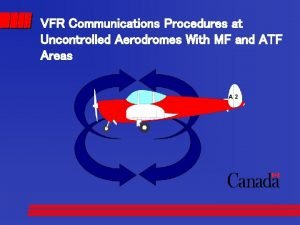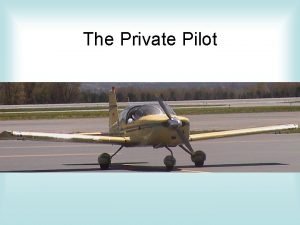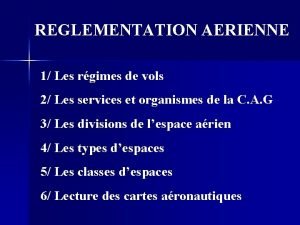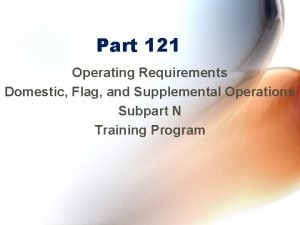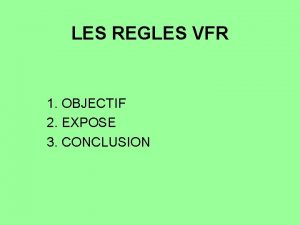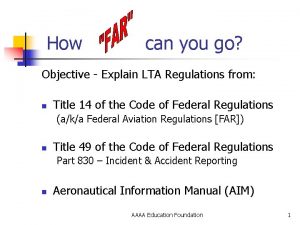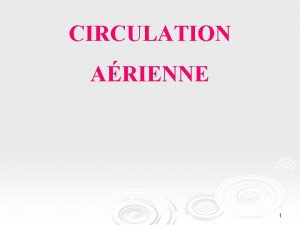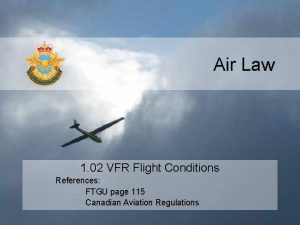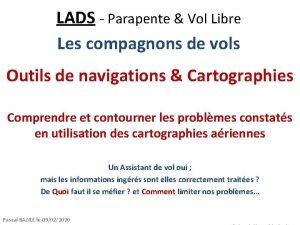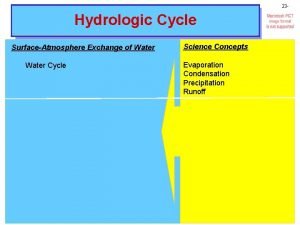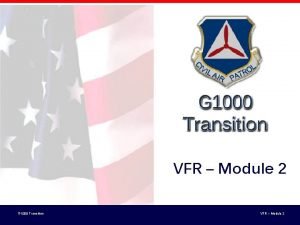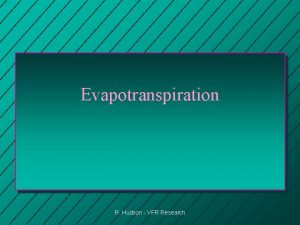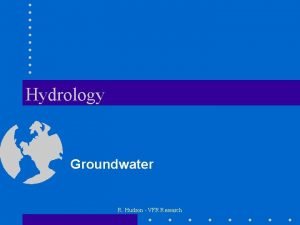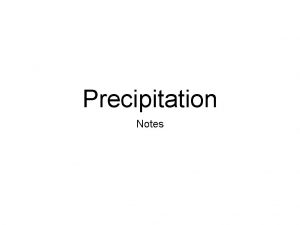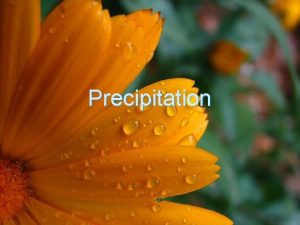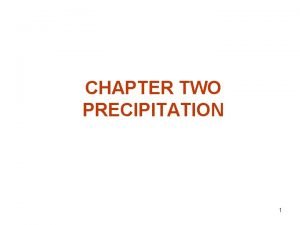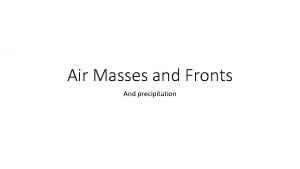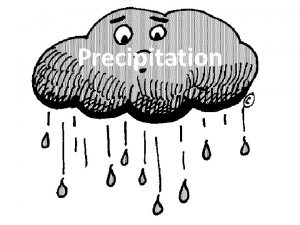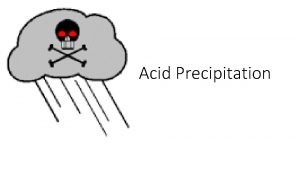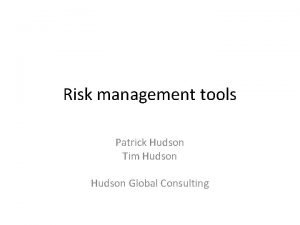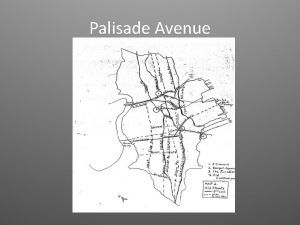Precipitation VFR Research R Hudson Precipitation Measurement Types
























- Slides: 24

Precipitation VFR Research - R. Hudson

Precipitation • Measurement • Types of precipitation • Precipitation distribution – seasonal – regional – topographic controls • Basin average precipitation VFR Research - R. Hudson

Total Precipitation = rain + snow Current standard: 16” diameter PVC standpipe gauge – 1 -2 metres gauge height – charged with antifreeze to melt snow falling into the gauge – circulating pump – pressure transducer measures gauge depth – depth recorded by a data logger VFR Research - R. Hudson

Rainfall Current and past standard for measuring rain only is the tipping bucket rain gauge – rain is funnelled into a collector mechanism that tips back and forth when a specific volume of rain is received – each tip activates a reed switch, number of tips are counted by a recorder – usually calibrated to 1. 0, 0. 5 or 0. 25 mm rain VFR Research - R. Hudson

Snowfall Snow is measured as water equivalent in units of depth (mm or cm). • AES method at manned sites: limited capacity, manually operated shielded gauges – usually emptied daily – water equivalent of snow caught in gauge is measured either by weighing or by melting the snow and measuring in a graduated cylinder VFR Research - R. Hudson

Precipitation gauge siting All precipitation gauges experience undercatch – wind exacerbates gauge undercatch: • causes ppt to fall at an angle less than 90 o – this affects rain and snow equally • the gauge will deform the wind field, creating updrafts and flow acceleration over the gauge orifice that inhibits ppt from falling in the gauge – this mostly affects snow, but can affect rain if gauge is poorly sited – if possible, gauge should be in sheltered site VFR Research - R. Hudson

Rain falls on different cross-sectional areas depending on angle of fall VFR Research - R. Hudson

Effect of rainfall angle on catch • Vertical rain sees a circular crosssection on the gauge – true “as calibrated” precipitation catch • Angular rain sees an elliptical crosssection with a larger area than true area of the orifice – a function of the angle at which the rain falls – catch ratio = orifice area/area of ellipse VFR Research - R. Hudson

Proper siting of a precip. gauge VFR Research - R. Hudson

Effects of wind on snow catch • Usually, precipitation gauges cannot be sited in small forest clearings, and must be located at open windy sites – alteration of the wind field over the gauge orifice affects snow more than rain – gauge shields reduce undercatch by reducing wind field deformation over the orifice – types of shields: • Nipher shield for manually read AES snow gauge • Alter shield for remote total ppt gauge VFR Research - R. Hudson

What causes precipitation? Primary cause of precipitation: lifting of moisture laden air • As elevation increases, pressure decreases – Boyle’s law: at constant temperature, as pressure increases, the volume decreases – Charles’ law: at constant pressure, as temperature changes, volume changes VFR Research - R. Hudson

Types of precipitation Ppt is typed according to the lifting mechanism that generates it • Cyclonic: lifting due to convergence into a low pressure cell – typical winter rains in coastal B. C. – wide spread, low to moderate intensity • Frontal: lifting of warm air over colder, denser air at frontal surface VFR Research - R. Hudson

Fronts – warm front: warm air advances over cold air • wide spread - 300 to 500 km ahead of front due to low slope of front (1/100 to 1/300) • continuous, low to moderate intensity – cold front: cold air advances under warm • more localized and more rapid lifting due to steeper frontal surface (1/50 to 1/150) • much higher intensities than warm front and less uniform VFR Research - R. Hudson

Convective / Orographic • Convective: lifting of unstable air that is warmer than surrounding air due to uneven surface heating – thunder storms – spotty and highly variable in intensity • Orographic: mechanical lifting over mountains – very important in B. C. - controls climate VFR Research - R. Hudson

Precipitation distribution • Rain vs. snow – simply a function of temperature, governed by season and elevation • Spatial distribution – topographic control of precipitation • local vs. regional • Seasonal distribution • Rainfall intensity-duration VFR Research - R. Hudson

Precipitation distribution • In B. C. , the most important effects are frontal and orographic – highest intensity storms on the coast are frontal, but the orographic effect works in conjunction with the front to produce very high volume and intensity of rainfall – orography generally defines B. C. ’s climate and biogeoclimatic zonation VFR Research - R. Hudson

Local orographic effects VFR Research - R. Hudson

Rain shadow effect • Moist air is forced over mountain barriers by westerly air flow • Ppt falls on windward (i. e. , west) side of mountain range while the leeward (eastern) side is warmer and drier – strongest contrast in B. C. is the transition from the wet west side of the Coast mountains to the Fraser Valley VFR Research - R. Hudson

Seasonal distribution Total Monthly Ppt. (mm) 200 Upper Penticton Creek 100 0 Total Monthly Ppt. (mm) 400 Russell Creek 300 200 100 0 J F M A M J J A S VFR Research - R. Hudson O N D

Rainfall intensity-duration • USA standard intensity criteria – Light: up to 2. 5 mm/hour – Moderate: 2. 6 to 7. 6 mm/hour – Heavy: over 7. 6 mm/hour • For a given storm, maximum insensity in mm/hour is inversely proportional to duration – temporal distribution of rain during a storm is not uniform VFR Research - R. Hudson

Types of Precipitation networks • Operational networks – Hydro – MOE – AES – Fire weather • Research networks – Density of network depends on purpose of research and resources VFR Research - R. Hudson

There are multiple networks. . . • Hydro: monitoring for dam and reservoir management • Highways: monitoring for road conditions – e. g. , Sea to Sky highway, there is a series of remote snow gauges at upper elevations to monitor snow and weather conditions to assess debris flow/avalanche hazard along the highway VFR Research - R. Hudson

Networks. . . • AES: mostly low elevation, volunteer manned on a daily basis • Fire weather: MOF and forest industry network to assess forest fire risk – seasonally monitored (April - October) – remote, a range of elevations VFR Research - R. Hudson

Networks. . . • MOE: mostly remote, high elevation – in conjunction with snow courses – runoff forecasting – jointly operated with WSC • Research networks – tend to be denser than operational networks – localized, specific to research objectives • Actual network density unknown VFR Research - R. Hudson
 Henry hudson lifespan
Henry hudson lifespan Steps of gravimetric analysis
Steps of gravimetric analysis Co precipitation and post precipitation
Co precipitation and post precipitation Earth energy budget
Earth energy budget Global precipitation measurement mission answer key
Global precipitation measurement mission answer key Measurement scales in research
Measurement scales in research Uncontrolled aerodrome procedures
Uncontrolled aerodrome procedures Which of the reporting stations have vfr weather?
Which of the reporting stations have vfr weather? Alerfa detresfa
Alerfa detresfa Vfr weather minimums
Vfr weather minimums Part 121
Part 121 Conclusion sur vol de nuit
Conclusion sur vol de nuit Nwkraft aviation
Nwkraft aviation Minimum safe altitude vfr
Minimum safe altitude vfr Minimum enroute altitude
Minimum enroute altitude Vfr special
Vfr special Vfr communications
Vfr communications Vfr weather minimum
Vfr weather minimum Vyčkávací obrazec
Vyčkávací obrazec Geoportail oaci vfr
Geoportail oaci vfr Fir athens
Fir athens Types of precipitation
Types of precipitation Types of precipitation
Types of precipitation Criteria for good measurement in research methodology
Criteria for good measurement in research methodology Measurement scales in marketing research
Measurement scales in marketing research




